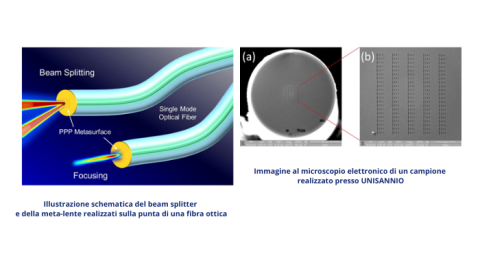Nanophotonic Devices in Optical Fiber: The Study by UNISANNIO
Integration of Metasurfaces and Nanotechnologies for a New Generation of Miniaturized Optical Components
The growing need to miniaturize devices and integrate them into complex circuits – such as those used in wearable sensors, optical neural networks, and next-generation nanoendoscopes for medical imaging – demands new functionalities from conventional optical fibers used in telecommunications, particularly in manipulating light radiation at the nanoscale.
Miniaturised optical multiplexers and optical fibres integrated with superlenses for advanced diagnostics represent today’s key challenges in modern nanophotonics.
It is precisely in this direction that the study conducted by researchers at the University of Sannio, in collaboration with the Regional Competence Centre on Information and Communication Technologies (CeRICT), is positioned. The goal is to develop multifunctional integrated optical components directly on the tip of an optical fibre – essentially, on a glass hair with micrometric dimensions.
This achievement has been made possible thanks to the extraordinary properties of optical metasurfaces and the use of powerful nanotechnologies available at CNOS (Centre for Nanophotonics and Optoelectronics for Human Health), a regional research infrastructure with high technological and scientific potential. CNOS offers excellent and multidisciplinary services, using enabling technologies such as nanotechnologies, optoelectronics, photonics, and modern biotechnologies.
Metasurfaces are artificial materials that overcome the physical limitations of natural materials, offering the ability to manipulate light at the nanoscale in previously unimaginable ways. The integration of these materials into optical fibres was demonstrated for the first time by UniSannio researchers in 2017 with the creation of the first “meta-fibre,” considered one of the flagship innovations of UniSannio’s research efforts.
In their new work, published in the journal Advanced Optical Materials (Wiley), the team employed next-generation metasurfaces based on the “partial-phase coverage” paradigm, achieving significantly higher performance compared to the early implementations of the past five years.
Specifically, they developed a multiplexer integrated onto the tip of a single-mode optical fibre and a meta-lens capable of focusing light just 7 micrometres from its end, offering tremendous potential in the field of medical imaging. This result paves the way for a new generation of fibre-integrated devices capable not only of transmitting light but also of manipulating, processing, and shaping it with extreme precision.
The study was led by Professors Maria Principe, Andrea Cusano, and Marco Consales from the Department of Engineering at the University of Sannio, and includes young researchers Patrizio Vaiano, Gaia Maria Berruti, and Alberto Micco.
The work is available online at the following link:
Optical Fiber Meta‐Tips Based on Partial‐Phase Control – Principe – Advanced Optical Materials – Wiley Online Library

